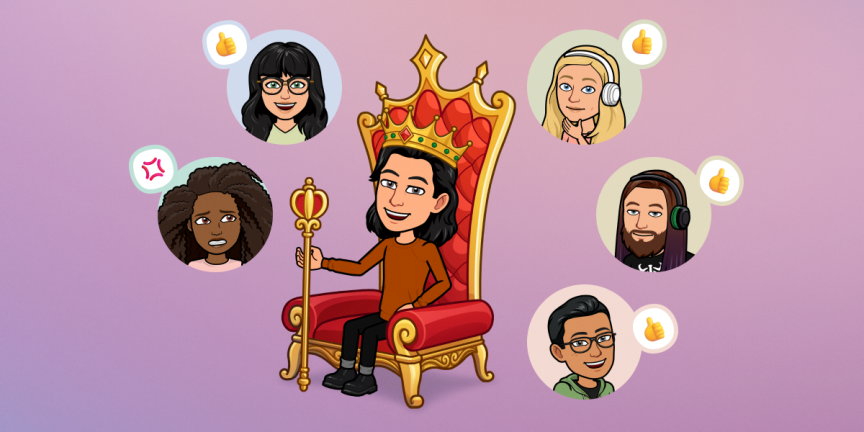Groupthink kills your retrospectives!


Have you ever felt like something - or someone - was pulling the strings of your team retrospective?
Have you ever experienced meetings where the participants would all end up saying the same things - but deep down, you feel that people do not seem sincerely comfortable with the established consensus?
If so, you probably have experienced what we call the "Political Vote". Reading this article will hopefully open your eyes to one of the most dangerous poisons in team meetings: groupthink.
Let's see how you can better spot the Political Vote symptoms - and fight them! - in your own team retrospectives.
In this article, we will cover the following topics:
What is groupthink?
If you want to beat groupthink, you need to clearly understand what it is first.
"Groupthink is a psychological phenomenon that occurs within a group of people in which the desire for harmony or conformity in the group results in an irrational or dysfunctional decision-making outcome. Cohesiveness, or the desire for cohesiveness, in a group may produce a tendency among its members to agree at all costs."
- Leadership Glossary: Essential Terms for the 21st Century
In a nutshell, groupthink often occurs when the group is highly cohesive, and the members are under pressure to conform to the group's opinions. As you may expect, this can lead to poor decision-making and a lack of creativity.
Although groupthink can happen in any group, let's focus on one core concept that particularly applies to team retrospectives: the Political Vote.
What is the Political Vote?
The Political Vote is one of the 24 antipatterns documented in the book Retrospectives Antipatterns by Danish author Aino Vonge Corry. We will explore the high quality and variety of the antipatterns described in this excellent book a bit later.
But before we start, let's take some precautions! If you're new to conducting retrospectives, make sure to read our introduction to the Agile Retrospective. You will find all the basic concepts you need to know before digging into the Political Vote, an antipattern often neglected by retrospective facilitators… even among the most experienced ones.
According to Aino Vonge Corry, the Political Vote is likely to occur when the team comes to the Voting step of their retrospective. After having shared many comments and ideas, the participants of a retrospective must prioritize the talking points that are most important to them. Hence the use of a prioritization technique such as dot-voting.
The author introduces the P.V. as follows:
"The Political Vote... in which the team members wait until the last moment to vote in order to game the system, and the facilitator finds a way to make the voting system more fair."
- Aino Vonge Corry, Retrospectives Antipatterns
To make your discovery more immersive, we have produced, in collaboration with Aino Vonge Corry, this short video dedicated to the Political Vote. Enjoy! 🎥
This retrospective antipattern generates a somewhat artificial consensus in which individuals seek to fall into line, through their votes, rather than authentically sharing their genuine opinions.
In the example of the Voting retrospective step raised by Aino Vonge Corry, the core issue is that participants agree to vote on elements without being convinced of the purpose of these elements.
Why should I care about groupthink in my retrospectives?
Everyone will agree that in any team meeting, and especially in team retrospectives, it is vital that everyone feels free to express themselves without fear.
So why would the Political Vote antipattern be a threat to your retrospectives?
The causes of this antipattern are many and varied. Here are four of the most common ones:
A member has strong leadership and significant influence over the rest of the group, so the team will listen to them and follow everything they say without restriction;
A manager attends the retrospective, and their presence embarrasses the participants. This scenario does not encourage discussing (or worse, confronting) the ideas pitched by the manager. Check out this article of ours to dive into this topic;
The participants are either demotivated or tired, or they no longer perceive the purpose of retrospectives. Thus, they want to bring this retrospective to an end as quickly as possible by following the ideas of the group;
The group's psychological safety levels are low, which actively prevents members from sharing.
Aino Vonge Corry insists on the need to eliminate groupthink during the voting stage. She says that failure to combat groupthink results in "an unacknowledged difference of opinion and a source of tension within the team".
To provide a straightforward answer to the question "Why should I care about groupthink in my retrospectives?", think about the consequences of low psychological safety levels on your team's performance.
Ignoring the danger of groupthink is to avoid facing the harsh reality of a failed retrospective. You know... this kind of retrospective where the members know even before the retro starts that it will benefit only a very limited number of people on the team.
Ignoring the harmful impact of both groupthink and the Political Vote in your team meetings is to accept that people cannot express themselves freely - on purpose.
How to avoid groupthink in my retrospectives?
Now that you know the danger of groupthink in retrospective meetings, you may wonder what techniques and tools can help you fight the Political Vote.
First, let's talk about the facilitation techniques that could help you improve the efficiency of your retrospectives.
According to Aino Vonge Corry, the use of anonymous voting is a very effective solution to restrict the chances of having people influencing each other. In this case, the author insists on the need to hide the identity of the person who voted.
Anonymous voting is, in most cases, easy to implement in a virtual environment. But what about retrospectives held in an office room, with real flesh-and-blood coworkers gathered around a table?
Setting up an anonymous vote in a face-to-face setting can be more difficult. This is why Aino Vonge Corry suggests an additional facilitation technique which she introduces as the "1-2-3 vote".
Concretely, the 1-2-3 vote consists in having all the participants vote simultaneously, preventing them from knowing about the vote of the other participants beforehand.
"When everyone votes at the same time, you get a truer picture of what the majority wants."
- Aino Vonge Corry, Retrospectives Antipatterns
You are now equipped to fight against groupthink and its antipattern, the Political Vote. But don't leave already!
Now is the time to consider the best tools that bring up a playful, productive, and groupthink-free retrospective experience.
Equip yourself with the best tool to beat groupthink in your Sprint retrospectives
In case you've missed it in our video dedicated to the Political Vote antipattern, Aino Vonge Corry recommends using Neatro for your distributed retrospectives.
But what makes Neatro the best solution for facilitating online retrospectives?
Here are three fundamental principles that we have incorporated into the Neatro experience to raise your team's psychological safety levels. And fight the Political Vote, of course.
1/ Neatro fights groupthink when your teammates post comments
The first step of the Neatro retrospective experience invites participants to share ideas without seeing what their coworkers think.
Therefore, each participant is encouraged to make comments that genuinely reflect their thinking. It is simply impossible to read the comments of the rest of the team throughout this step.
It is important to note that a member can choose to share a comment with their name attached to it or in anonymous mode. This choice remains at the member's discretion for each comment.
By combating groupthink right from the very beginning of the retrospective experience - when people start sharing ideas - Neatro strongly encourages participants to express themselves authentically. Without fear of reprisals. Without risks of being influenced by the rest of the group.
2/ Neatro isolates participants when voting
After sharing and regrouping comments, participants proceed to the voting phase.
Note that the retrospective facilitator can adjust the number of votes per participant.
Members use their votes to prioritize discussion topics that they feel are most important to address for the upcoming action plan phase.
The particularity of the Neatro experience is that participants can in no way see who is voting on which element. Also, people do not know the total number of votes on a particular comment at this retrospective stage.
It feels like each participant would be comfortably installed in their bubble, sheltered from any external influence.
Imagine a regular voting booth like when you go to an election. Neatro offers you the guarantee that no one will ever sneak a peek at your votes. So you can cast your votes with complete peace of mind.
This feature makes Neatro stand out from the competition, especially from virtual whiteboard tools such as Miro or Mural. If you have ever done a retrospective with one of these solutions, you have probably observed that it may be complicated to avoid participants influencing each other. Both during the comments phase and the voting phase.
3/ Neatro guarantees the anonymity of votes
The votes of the participants always remain anonymous with Neatro. Because of this, no one will ever know who voted on which particular item. Only the total number of votes for each item will be known to everyone.
Simply put, Neatro was built to enhance your team's psychological safety levels and wipe out the Political Vote from your retrospectives, once and for all! 💪
Check out our collection of retrospective activities; you will certainly find the perfect format for your next session.
You can try the Neatro experience for free by following this link. No credit card is required.
Discover Retrospectives Antipatterns, a must-have book!
Today, you've learned about the Political Vote antipattern. And you might be wondering why you hadn't identified it earlier in your own retrospectives.
Don't be too harsh on yourself: although the concept of psychological safety has gained popularity over the last ten years, just a few books deal with the dangers of groupthink in retrospective meetings.
Agile Retrospectives: Making Good Teams Great and Project Retrospectives: A Handbook for Team Reviews are two masterpieces that have contributed to structuring and spreading the practice of retrospectives.
But one book has hooked us and won a special place in our hearts: Retrospectives Antipatterns.
As mentioned in the introduction of this article, the Political Vote is only one of the 24 antipatterns documented in Retrospectives Antipatterns.
With remarkable accuracy and a touch of humor, Aino Vonge Corry reviews embarrassing situations that all retrospective facilitators have already experienced in their lives - or will end up encountering at some point!
So what can you expect from this book? Stories and tools to help you become a more experienced retrospective facilitator, of course!
Here are some of the 24 antipatterns narrated in Retrospectives Antipatterns:
"Nothing to Talk About"... in which the team believes it has become so good that it doesn't need retrospectives, and the facilitator shows the team how it can learn to keep improving!
"Peak-A-Boo"... in which team members will not show their faces on the video in an online retrospective, and the facilitator learns why and finds ways to make it safer for people to show their faces!
"Loudmouth"... in which a team member needs to hear him - or herself all the time, at everyone else's expense, and the facilitator applies various tactics to ensure the rest of the team is heard!
Fun fact: "I thought I was the only one who experienced this!" is something you may tell yourself when traveling through the 24 antipatterns delivered in this book. In Retrospectives Antipatterns, Aino Vonge Corry's experience and expertise are truly demonstrated across a huge variety of practical cases.
At Neatro, we loved reading (and re-reading) Retrospectives Antipatterns. Aino Vonge Corry's work has greatly influenced the work of our team, and we would like to thank her for her creation which has enabled us to build a retrospective tool that makes us very proud today.
Pick up your own copy of Retrospectives Antipatterns by following this link. Enjoy!
Until then... beware of groupthink! 🤓



